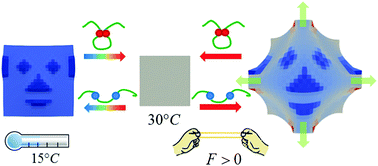“Patterning with loops” to dynamically reconfigure polymer gels
Abstract
The structural and mechanical properties of gels can be controlled by promoting the unfolding (and refolding) of loops (stored lengths) embedded within the networks. As a loop unfolds, the released chain length can increase the extensibility and reconfigurability of the gel. Here, we develop a theoretical model that couples the elasticity of the gel to the dynamic transitions occurring in loops that lie between the crosslinks. Using this model, we show that a thermally-induced swelling of the gel generates an internal strain, which unfolds the loops and thereby further increases the degree of gel swelling. We exploit this cooperative behavior to reconfigure the gel by patterning the location of the loops within the sample. Through this approach, we convert flat, two-dimensional layers into three-dimensional forms and introduce architectural features into uniform 3D slabs. At a fixed temperature, an applied force produces analogous structural transformations. The shape-changes are reversible: the systems return to their original structure when the temperature is reset or the force is removed. The findings provide guidelines for creating materials that interconvert thermal, chemical and mechanical energy to perform work. Such systems could be useful for designing soft robotic materials that convert environmental stimuli into useful functionality.



 Please wait while we load your content...
Please wait while we load your content...
